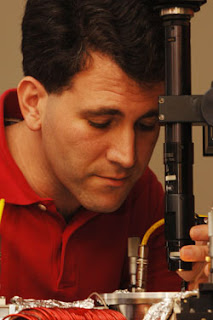 | Latest nanofabrication methods yield new clues about well-studied mineral
HOUSTON -- Dec. 17, 2007 -- Using the latest methods for nanofabrication, a team led by Rice University physicists has discovered a surprising new electronic property in one of the earliest-known and most-studied magnetic minerals on Earth -- lodestone, also known as magnetite. |
By changing the voltage in their experiment, researchers were able to get magnetite at temperatures colder than minus 250 degrees Fahrenheit to revert from an insulator to a conductor. The research was published online Dec. 16 and will be included in February's print edition of Nature Materials.

Doug Natelson and Rice physicists have discovered a surprising new electronic property in one of the earliest-known and most-studied magnetic minerals on Earth -- lodestone, also known as magnetite. | "It's fascinating that we can still find surprises in a material like magnetite that has been studied for thousands of years," said lead researcher Doug Natelson, associate professor of physics and astronomy. "This kind of finding is really a testament to what's possible now that we can fabricate electronic devices to study materials at the nanoscale."
The magnetic properties of lodestone, also known as magnetite, were documented in China more than 2,000 years ago, and Chinese sailors were navigating with lodestone compasses as early as 900 years ago.
Magnetite is a particular mineral of iron oxide. Its atoms are arranged in a crystal structure with four oxygen atoms for every three of iron, and their arrangement gives the mineral its characteristic magnetic and electrical properties. Physicists have known for more than 60 years that the electronic properties of magnetite change radically and quickly at cold temperatures. As the material cools below a critical temperature near minus 250 degrees Fahrenheit, it changes from an electrical conductor to an electrical insulator -- a electrical transformation that's akin to the physical change water undergoes when it freezes into ice. |
"When we applied a sufficiently large voltage across our nanostructures we found that we could kick the cooled magnetite out of its insulating phase and cause it to become a conductor again," Natelson said. "The transition is very sharp, and when the voltage is then lowered back below a lower critical value the magnetite snaps back into its insulating phase. We don't know exactly why this switching occurs, but we think further experiments will shed light on this and the nature of the insulating state."
With engineers looking to exploit novel electronic materials for next-generation computers and hard drives, phase transitions between insulating and conducting states have become an increasingly hot research topic in physics and materials science in recent years.
The debate about the causes and specifics of magnetite's temperature-driven phase change has simmered much longer. Natelson said physicists have long sparred about the possible underlying physical and electronic causes of the phase transition. The discovery of this new voltage-driven switching provides new clues, but more research is still needed, he said.
"The effect we discovered probably wasn't noticed in the past because nanotechnology is only now making it possible to prepare the electrodes, nanoparticles, and thin films required for study with the precision necessary to document the effect," he said.
Natelson's team experimented on two kinds of magnetite. One, called nanorust, consists of tiny particles of magnetite developed in the laboratory of Rice chemist Vicki Colvin, director of Rice's Center for Biological and Environmental Nanotechnology. The second, thin films of single-crystal magnetite, were produced by Igor Shvets' research group at the University of Dublin's Trinity College. These high quality materials with precise compositions were essential to the study, said Natelson. ###
Contact: B.J. Almond
balmond@rice.edu 713-348-6770
Rice UniversityTechnorati Tags:
Nano or
Nanotechnology and
Nanotech and or
nanofabrication and
Rice University or
Mike Huckabee Iowa Caucus Victory Speech VIDEO and
Broad-banded Copperhead (Agkistrodon contortrix laticinctus) and
UCLA-industry partnership to develop, commercialize new nanotechnology
















No comments:
Post a Comment